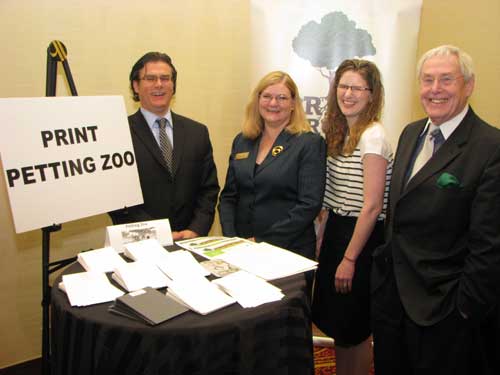Is print versus electronic the right question an association should ask if it wants to be socially responsible in its printing?
Speakers at a “Greening Your Meeting through Greener Printing” event held April 2
by the ASAE Convene Green Alliance at the Washington Marriott at Metro Center answered that question by saying that no one should feel guilty about printing anything as long as it is done sustainably, and the two options should be used in tandem for maximum marketing impact.
Best of all, sustainable printing can fit into any budget and no longer must cost more than traditional printing, say procurement specialist Derek Smith and green printer Kevin McKenney of Goetz Printing. Much of that is due to greater availability and innovation, with banana leaves, wheat, silk, bagasse grass, bamboo, eucalyptus, elephant dung, organic cotton, hemp, and recycled construction stone among the latest eco-friendly papers available for printing anything an association needs.
Varnishes and inks, too, have gone greener while still offering such unusual high-impact opportunities as scent infusion, multi-textured treatments and fluorescent inks. Attendees at the event were able to touch, smell and examine many of these underused paper options at the event’s unique “petting zoo.”
Working with one of the increasing number of green-certified printers will help organizations choose the proper paper, inks, and finishes to communicate effectively to their diverse audiences while reducing their eco-footprint.
Such projects also are made much easier by the worldwide availability of 50 environmental certifications for paper, forest management, and printers by third-parties and nonprofits such as the Sustainable Forestry Initiative Inc. (SFI) and Forestry Stewardship Council. Almost 10 percent of the world’s forests are certified.
Amy Doty, manager of community outreach for SFI, described the organization’s program and the elements of forest certification, such as decision-making based on input from social, economic, and environmental factors, protecting at-risk species and wildlife, establishing sustainable harvest levels, and publicly available third-party audits of forest management and manufacturing organizations.
Doty recommended looking for the SFI certification labels on products to ensure that the paper has come from certified producers. She also emphasized using a printer certified to the SFI Chain of Custody Standard.
McKenney agreed with Doty that printers should be working with certified chains of custody to ensure that products are obtained and produced as responsibly as possible. Printers also should offset their environmental impact via alternative energy sources such as wind and solar or reforestation certificates.
Derek Smith listed three things that meeting professionals and marketers should do to print green:
• Source paper from sustainable forests.
• use paper composed of at least some recycled fiber; and,
• Source from pulp mills, paper mills, distributors and printers that are committed to and practice sustainability.
He noted early in the session that the argument of “paper kills trees” makes no business sense for anyone since, without trees, no paper industry exists. Although less than 10 percent of timber goes to paper production, the industry is involved in a significant portion of the sustainability projects involving the world’s forests.
Smith urged meeting professionals who believe that e-documents are always a greener alternative to printed documents to calculate the carbon footprint of manufacturing, transporting, operating, and disposing of electronic devices. He said that all of those steps require a large amount of fossil fuels, so the end result many not be nearly as green as people think.
The CGA event also featured a short talk by executive chef Stephen Malfatti about the sustainable food and beverage practices at the Washington Marriott at Metro Center to highlight Marriott International’s ongoing goal of reducing its environmental footprint while ensuring excellent customer experiences. Malfatti’s menu featured locally grown, Fair Trade-certified, and organic products, including cage-free eggs, Fair Trade coffee, “superfoods,” such as berries and dark chocolate, and – their specialty – vegan options.
More information about the Convene Green Alliance is available online at www.convenegreen.com.
The ASAE Convene Green Alliance is a free community of sustainably minded association and nonprofit meeting professionals and industry partners from around the United States. The CGA mission is to provide education, share first-hand experiences, network with peers and hospitality experts and leverage the collective voice and buying power of all CGA members to lessen the environmental impact of associations and the meetings and events they sponsor.






























